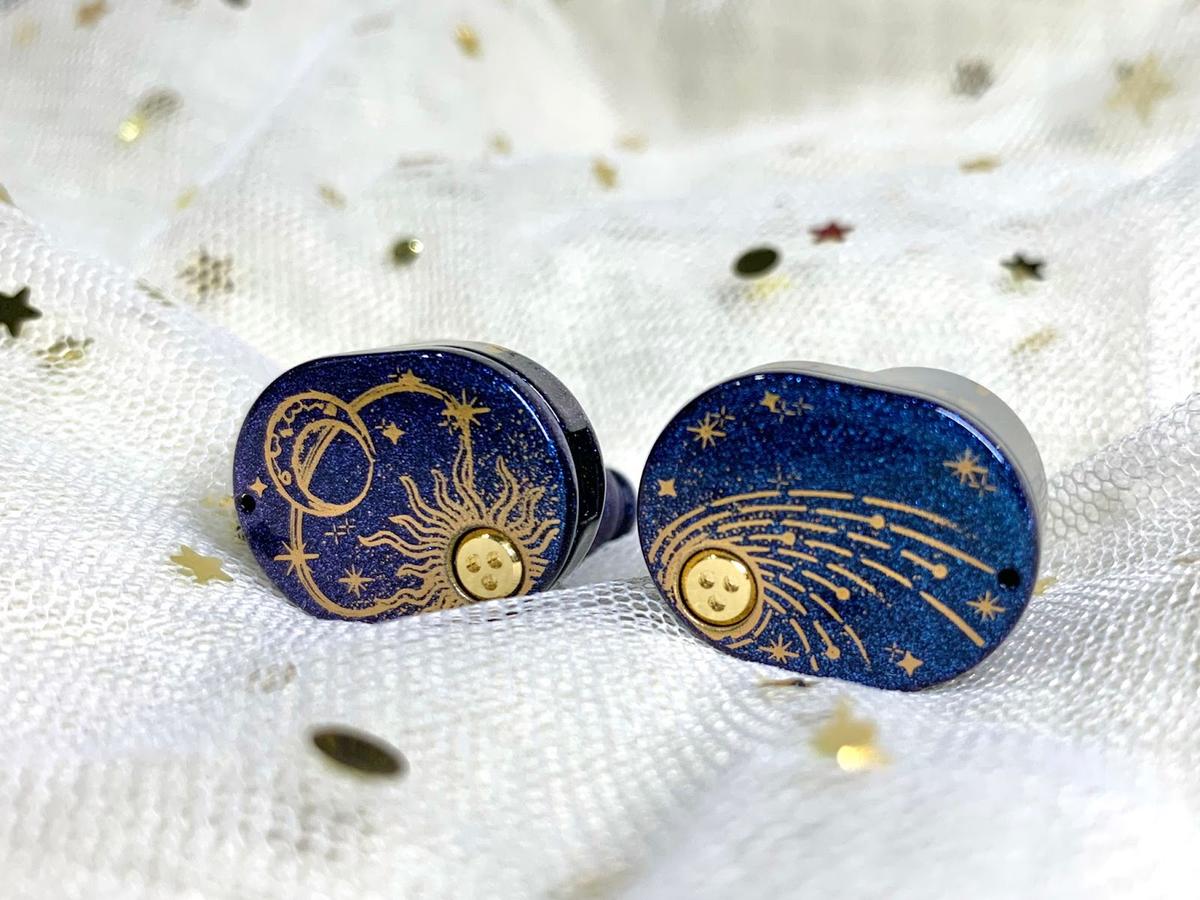Shoot for the moon. Even if you miss, you’ll land among the stars.
Planar IEMs are all the rage nowadays. Even bigger brands have a FOMO (fear of missing out) on the planar pie, and Moondrop has entered the fray with the Stellaris, hoping to capture a piece of this rocketing success.
The quote “Shoot for the moon. Even if you miss, you’ll land among the stars” by Norman Vincent Peale captures the essence of the Stellaris. The term stēllāris can be defined as “pertaining to a star.”
- Well accessorized
- Superb technicalities
- Lightning-quick transients, excellent clarity
- Poor fit due to heavy shells with long nozzles
- Tangly stock cable
- Sub-par isolation
- Difficult to drive
- Very niche and polarizing tonality, likely too bright for most consumers
- Nasal timbre
Is it written in the stars that the Stellaris will soar above the rest?
Company Overview
Moondrop was formed in 2015, and since then, has come leaps and bounds and is now arguably one of the preeminent leaders in the CHI-FI industry.
Moondrop is popular among CHI-FI enthusiasts and have released several crowd-favorite IEMs, such as the CHU, Blessing 2, Dusk, Aria 2021, Aria Snow Edition, KATO, and Starfield (to name a few).
Moondrop has even ventured into earbuds, some considered best-in-class (e.g., Chaconne and Liebesleid). Moondrop recently entered the TWS game with the Sparks and Nekocake and the headphone market with the Void.
Technical Specifications
- Form: IEMs
- Drivers: 14.5mm planar driver
- Impedance (Ohm): 36Ω +/- 15% (@1kHz)
- Sensitivity (dB): 117dB/Vrms (@1kHz)
- Frequency Response (Hz): 20 Hz – 20 kHz
- Removable Cable: Y
- Source Plug: 3.5 mm TRS, single-ended
- Cup/Shell Plug: 0.78 mm, 2-Pin
Packaging
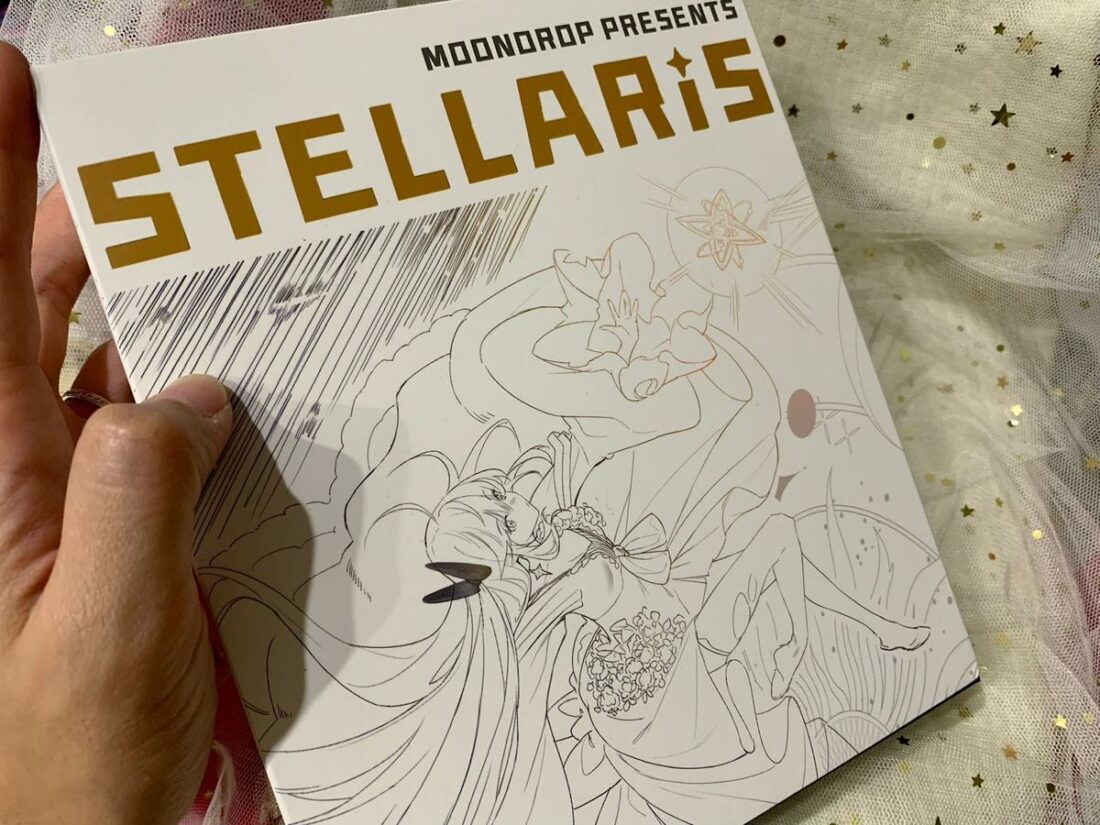
In the box
- Moondrop Stellaris IEMs
- 3 pairs of Softears Ultra Clear (UC) silicone ear tips (S, M, L)
- 3 pairs of MIS-Tip foam ear tips (S, M, L)
- Cable
- Leatherette carry case
- Anime waifu postcard
The accessories are decent enough for a pair of mid-fi IEMs.

The UC tips are grippy yet soft. They are marketed to fit better than standard silicone tips, as they cover more of the external ear canal. As such, these do provide a better seal, with improved isolation and less bass loss.
The included MIS-Tip foam tips provide excellent isolation, and they also tame the treble to boot. As we will read below, the Stellaris are very bright, and these foam tips are a helpful addition to balance the treble.
Cable
Moondrop makes no mention of the material used in their stock cable. Suffice to say, said cable is quite thin and tangly, and I have seen better stock cables from a haptic point of view.
With some planar rivals like the LETSHUOER S12 Pro providing a modular cable (that allows various distal terminations), it is quite a disappointing contrast to see that Moondrop has kept it to a 3.5mm option only.
Thankfully, this cable is quite microphonic-free. There’s a chin cinch to give added stability during usage.
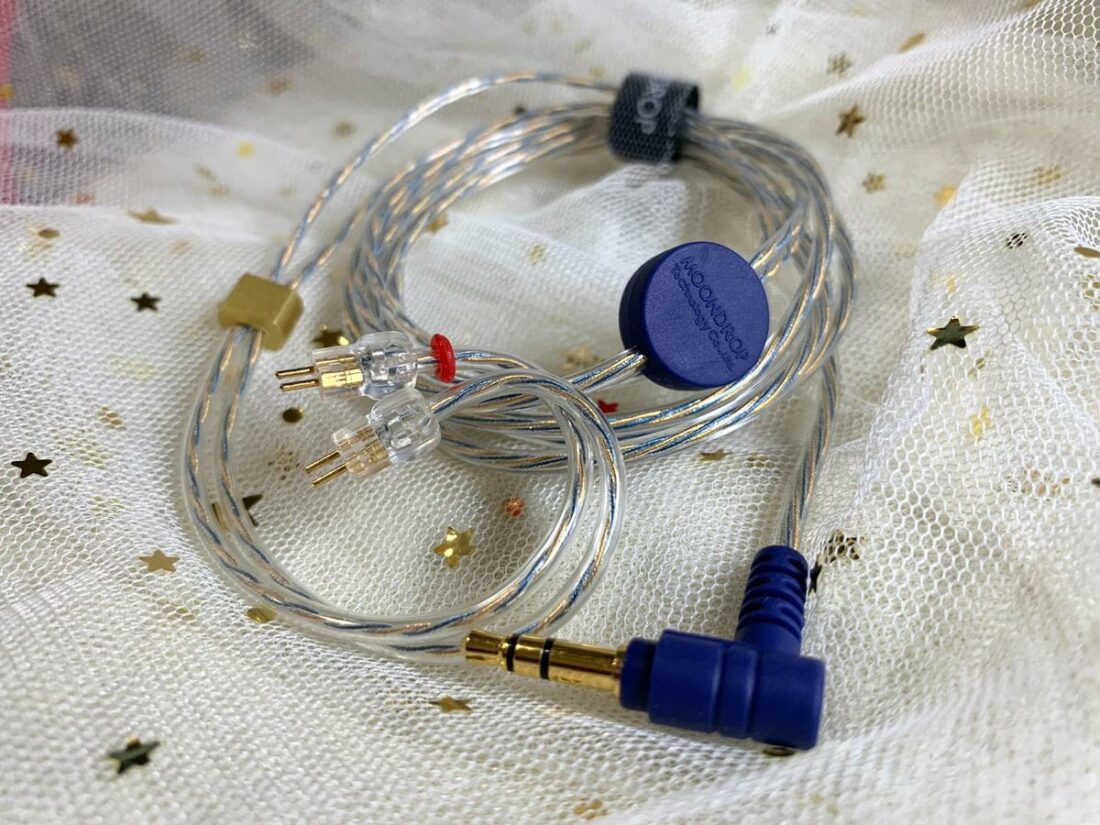
A 2-pin cable is always welcome in my book, as I had my fair share of MMCX mishaps with frequent cable changes.
Case

The blue leatherette case is semi-rigid, with an inner-lined velvet layer and a magnetic clasp.
Design
The shells feature an astronomical-themed motif, not dissimilar to that seen in the Moondrop Starfield.

The housings are ovoid with huge vents. Moondrop says that the acoustic structure of the shells are modified to accommodate cavities that control resonances and optimize distortion.
The shells have L and R lettering to delineate the left and right sides of the earpieces, respectively.
Comfort
The Stellaris, unfortunately, suffer from a double-whammy of heavy and huge shells coupled with very long nozzles. Each shell weighs almost 30g apiece, and the bulk of the center of gravity is focused away from the nozzles, causing the earpieces to drop out of the ears during use.
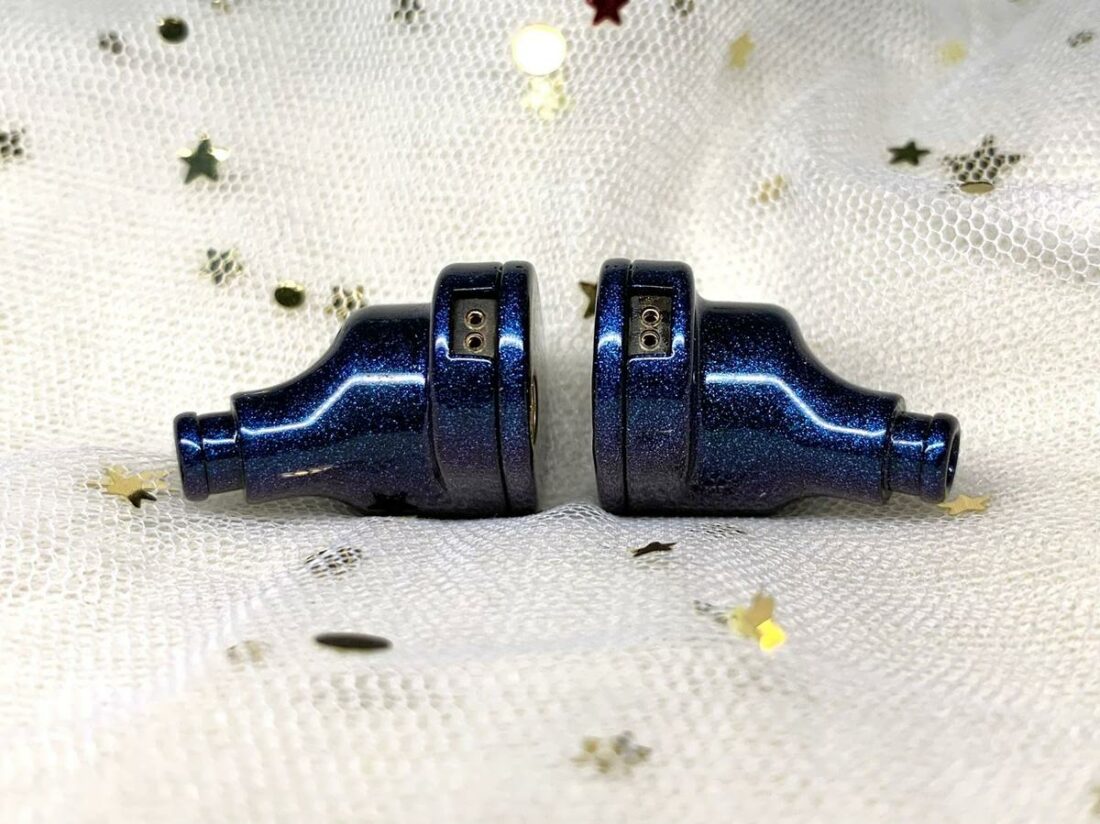
In practice, this may cause discomfort for users, both from an ergonomic and weight perspective.
To make matters worse, the poor fit may not only cause discomfort but also influences the seal in the ear, which affects isolation and skews the perceived sound. The Stellaris (as we will discuss below) are already very bright, and compounding a bad seal will lose the bass frequencies and possibly cause them to sound even brighter.
I’m sure most users will agree that having the most heavenly sound is useless if one cannot tolerate the comfort of an IEM for more than a few minutes.
Even when an optimal fit is achieved, isolation is sub-par due to the large vents on the housing.
Internals
Moondrop has collaborated with Tuoyin Electronics to manufacture the 14.5mm planar driver used in the Stellaris. The latter has an excellent track record of producing miniature planar drivers, and this 14.5mm driver purportedly has industry-leading quality (in terms of reliability and sonic performance).
The Stellaris’ planar drivers have a sub-nanometer diaphragm with a 2um etched circuit. This uber-thin diaphragm is advertised to lower vibration and distortion. The drivers also contain a high-precision miniature grid magnet array with 14 symmetrical N52H magnets. These lower harmonic distortion and produce a magnetic flux close to 1 Tesla, which results in greater clarity.
Moondrop Stellaris Sound
The Stellaris are rather difficult to drive. Amplification is highly recommended.
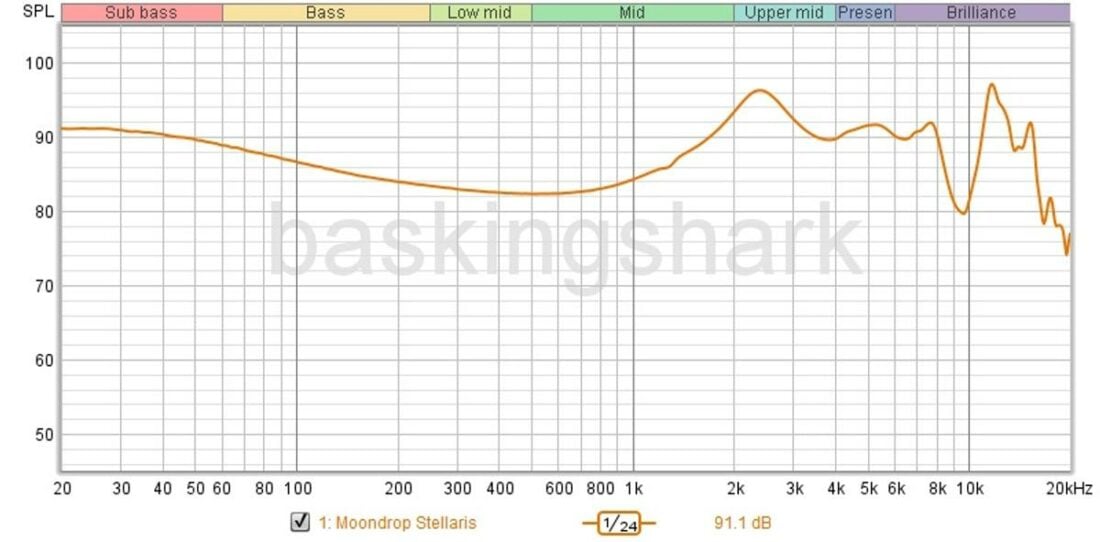
The Stellaris sport an extremely bright tuning. There’s a peak around the 2-3 kHz regions, and the treble continues to be boosted after that.
If one has heard the Moondrop SSR before, the Stellaris are an SSR on steroids.
This treble-focused signature is very niche – it will be a love-it or hate-it kind of affair – treble-heads may rub their hands with glee, but most other consumers will find them to be akin to chalk grating on a blackboard.
Note weight is very thin, though transients are lightning quick. Due to their very sterile sonic profile, the Stellaris are best paired with analogue-sounding or warmer sources rather than analytical or brighter ones.
Unfortunately, the overly magnified upper frequencies and thin note weight give an unnatural timbre for vocals and acoustic instruments. Vocals sound nasal, and notes lack weight and density.
One area where the Stellaris stand out is in the area of technicalities. Verily, they are outstanding in this aspect – clarity, instrument separation, micro-details, imaging, and transients can beat most of their other planar rivals. The soundstage is expansive.
If one wants a set for critical listening and to analyze every fine nuance of music, the Stellaris are arguably IEMs to consider.
Bass
Bass is very swift and tight but lacks decay and movement of air, as per most planar IEMs. The bass is sub-bass focused with moderate extension.
While there is no mid-bass bleed, and texturing is excellent, there is a lack of bass punch and rumble. Bassheads will find the bass amounts wanting, but the Stellaris definitely focuses on bass quality over quantity.
Midrange
There’s a slight lower mids depression. Thereafter, the midrange is very clear and transparent, aided by the lack of a prominent mid-bass. Layering of instruments is very well done due to the aforementioned transparency, expansive soundstage, and precise imaging.
The upper mids are not as scary as the graphs seem to indicate, but they can veer to shoutiness, especially at louder volumes (Fletcher Munson curve).
Treble
Treble is very extended, sparkly, and airy, in keeping with their spacey and astronomical appellation. Micro-details are generously sprinkled like stars in the soundscape, albeit sibilance is marked, and high hats and cymbals sound splashy and over-emphasized.
The Stellaris’ treble is fatiguing, and treble-sensitive folk may find the tuning polarizing. On the flip side, treble-heads will enjoy the tuning, so as alluded to, this is a love-it or hate-it tuning choice that Moondrop has chosen here.
In a nutshell, the tonal issues do mar the marvelous technicalities and perhaps even cause the Stellaris to be perceived as a one-trick pony.
However, all is not lost. Pairing the Stellaris with a warmer source, or using foam tips or treble-attenuating silicone tips like the Final E Black tips, can somewhat mitigate the harsh treble. Even EQ can be an option if one is not averse to it.
Modifications
For hands-on folk, thank our lucky stars that stacking an aftermarket Tanchjim Tanya filter (which cost a few cents) over the nozzle of the Stellaris can tame the upper mids/treble, and make the tonality and timbre much more palatable.
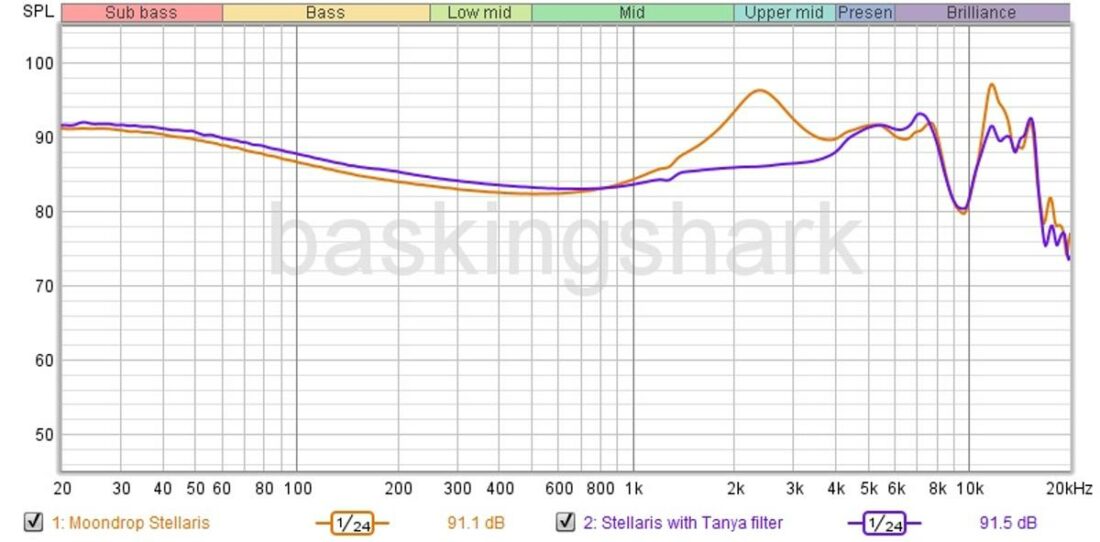
The Tanya filters are easy to install and reversible; said filters have an adhesive over the back to be stuck on the nozzle’s circumference.
The filters can be bought online at various shops, or they come with a purchase of an ultra-budget Tanchjim Tanya. On audio forums, tinkerers actually buy a pair of Tanya IEMs just to get their paws on these filters, which are very useful for modding and taming brighter IEMs, such as the Tripowin Olina.
Comparisons
The Stellaris will be compared against their other planar brethren. BAs, single DDs, hybrids, and other driver types are omitted, as the different transducers have their own pros and cons.
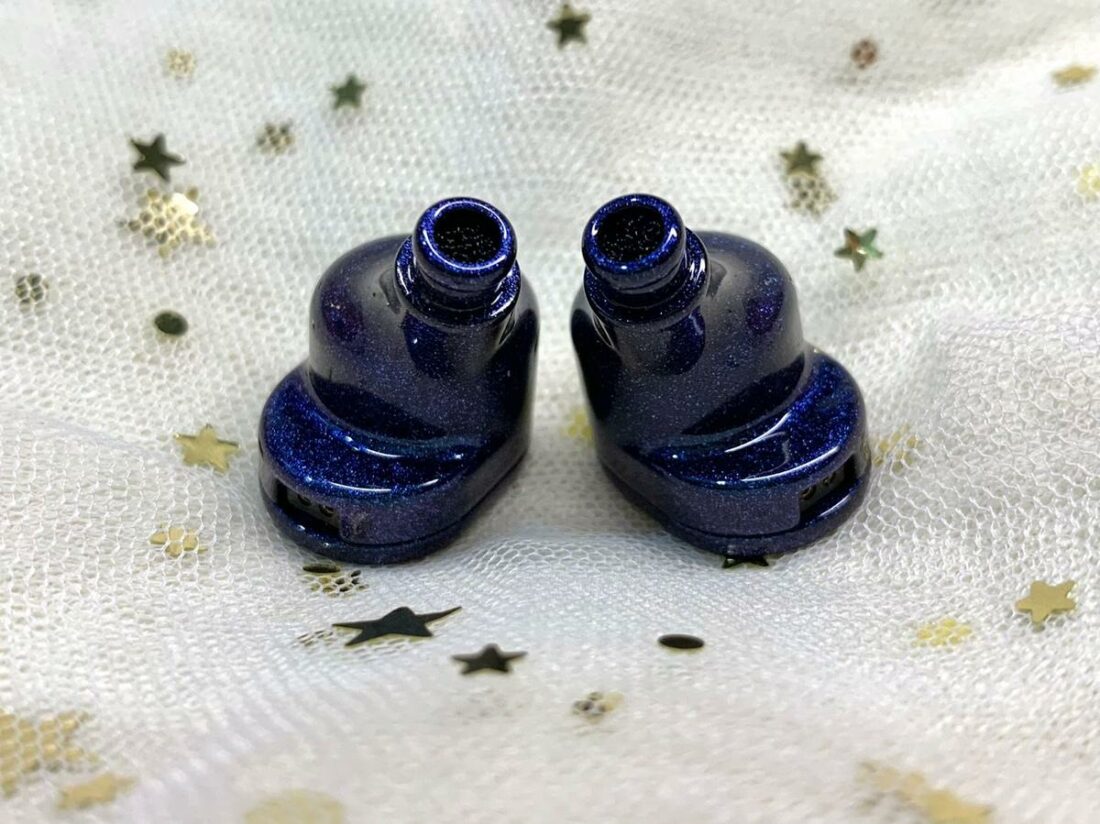
Vs. LETSHOUER S12 Pro
The S12 Pro are a V-shaped pair. They are bassier, though bass quality is not as tight as on the Stellaris. The S12 Pro are less analytical and sound more “fun” than the Stellaris.
The S12 Pro are a bright set. Having said that, the Stellaris are even brighter, with a thinner note weight!
There are already multiple forum reports of treble-sensitive folk unable to tolerate the S12 Pro’s treble quantity, and the Stellaris surely fare worse in this aspect.
In technicalities, the Stellaris are ahead, with better soundstage, imaging, instrument separation, clarity, micro-details, and transients. However, the S12 Pro have slightly better timbre and are more versatile in terms of tuning.
The S12 Pro have a better fit, and their included cable has modular options for various balanced and unbalanced connectors, unlike the thin and tangly stock cable of the Stellaris.
Vs. Tangzu Audio Zetian Wu
The Zetian Wu are bassier and darker, with a thicker note weight. The Zetian Wu have a more natural tonality and superior timbral accuracy. Compared to the Stellaris, they are also smoother, with minimal sibilance and fatigue.
The Stellaris are a league or two ahead in technical aspects such as clarity, micro-detailing, soundstage, imaging, and instrument separation. Bass tightness and speed are also better on the Stellaris.
The Zetian Wu have a better fit, with a more ergonomic design and lighter shells.
Vs. DUNU Talos
The Talos are a unique pair of IEMs that can be converted to a hybrid (BA + planar) mode with the flick of a switch. Turning off the switch lets them remain as a pure planar set.
To pit apples to apples, ideally, only the pure planar mode should be used for comparisons. Suffice to say, the Talos’ hybrid mode is very bright and fatiguing and is akin to the Stellaris in tonality. Indeed, most consumers on forums seem to dislike the hybrid mode and mostly turn off this switch.
The pure planar mode of the Talos gives a neutral bright tonality, with less upper mids and treble than the Stellaris but similar bass amounts. The Talos have a thicker note weight and a more natural timbre and tonality.
Even in the pure planar mode, the Talos are no slouch in technicalities. Having done extensive A/B comparisons, in this mode, the Talos have just a hair worse imaging, clarity, and soundstage. However, if the hybrid mode is activated, the Talos have the upper hand in technical performance.
Fit is slightly better on the Talos, and they are better accessorized too.
Even though the Talos are pricier, I do think the additional top-up is worth the coin, as they are superior in most departments and make better all-rounders. Additionally, the Talos are more versatile; one can easily activate the hybrid switch if a treble-head tonality and superior technicalities are desired.
Where to Buy
Conclusion
Sadly, the stars are not aligned for Moondrop’s first foray into the cut-throat planar market.
Moondrop possibly may have wanted to launch something different from the current star-studded crop of planars, focusing on outright technicalities. Unfortunately, these tuning decisions inadvertently have come at the expense of tonality and timbre, leading to glaring flaws.
The Stellaris are literally brighter than the stars – they display an extremely polarizing tonality, which will turn away all but the most ardent of treble-heads. The Stellaris are also not easy to drive, so enthusiasts using weak sources will need to look elsewhere.
Another potential issue: the long nozzles and heavy shells make the fit quite problematic. Fit not only influences comfort and isolation, but most importantly, the sound signature. Bass frequencies may be attenuated with a sub-optimal fit, making an already bright Stellaris even brighter.
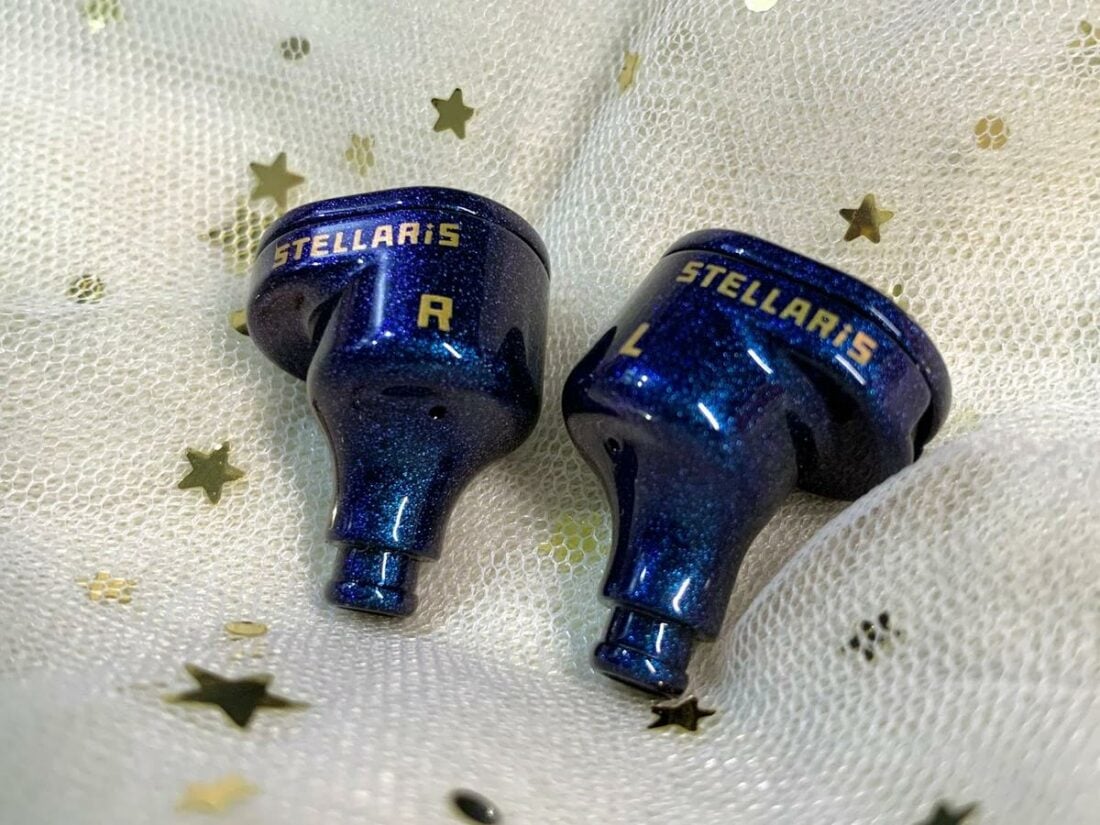
Having said that, the Stellaris are extremely competent in technicalities, and best most of the other planar competitors in this department, perhaps other than the DUNU Talos in hybrid mode. And thankfully, simple maneuvers like EQ, tip-rolling, or even sticking a cheap Tanya filter may somewhat salvage the tonality.
Putting the Talos aside, at the end of the day, there are also a dime-a-dozen other pure planar contenders that have slightly poorer resolution but a more natural timbre and tonality. In addition, these nemeses have better fit and are all-rounder generalists for a myriad of music genres, unlike the treble-focused Stellaris.
I do think there’s huge potential with the 14.5mm planar drivers used in the Stellaris. If Moondrop can fix the issues of fit and tonality, a new star might yet be born.
